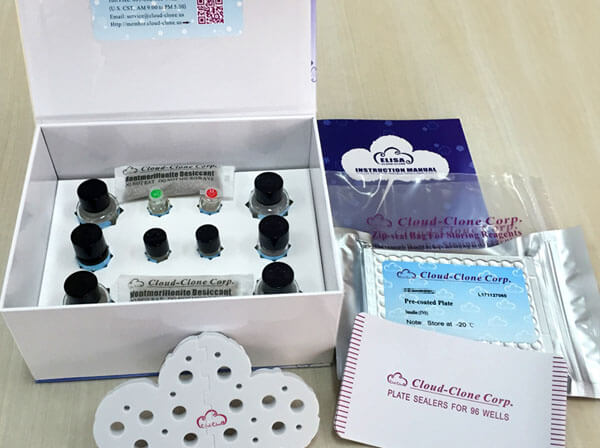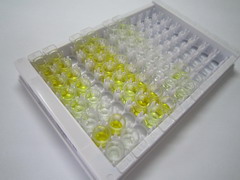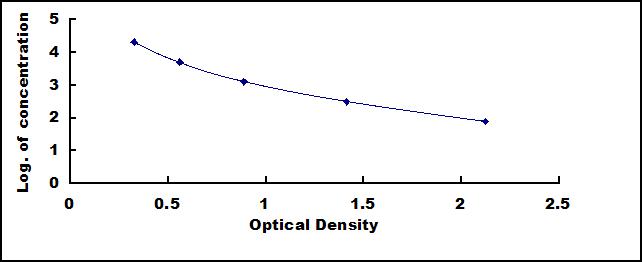ELISA Kit for Lysophosphatidylcholine (LPC) 

lysoPC; Lysolecithin; 1-Palmitoyl-sn-Glycero-3-Phosphocholine
- UOM
- FOB US$ 571.00 US$ 816.00 US$ 3,672.00 US$ 6,936.00 US$ 57,120.00
- Quantity
Overview
Properties
- Product No.CEK621Ge
- Organism SpeciesPan-species (General) Same name, Different species.
- ApplicationsEnzyme-linked immunosorbent assay for Antigen Detection.
Research use only - DownloadInstruction Manual
- Category
Sign into your account
Share a new citation as an author
Upload your experimental result
Review

Contact us
Please fill in the blank.
Recovery
Matrices listed below were spiked with certain level of recombinant Lysophosphatidylcholine (LPC) and the recovery rates were calculated by comparing the measured value to the expected amount of Lysophosphatidylcholine (LPC) in samples.
| Matrix | Recovery range (%) | Average(%) |
| serum(n=5) | 96-103 | 99 |
| EDTA plasma(n=5) | 90-102 | 99 |
| heparin plasma(n=5) | 78-102 | 88 |
Precision
Intra-assay Precision (Precision within an assay): 3 samples with low, middle and high level Lysophosphatidylcholine (LPC) were tested 20 times on one plate, respectively.
Inter-assay Precision (Precision between assays): 3 samples with low, middle and high level Lysophosphatidylcholine (LPC) were tested on 3 different plates, 8 replicates in each plate.
CV(%) = SD/meanX100
Intra-Assay: CV<10%
Inter-Assay: CV<12%
Linearity
The linearity of the kit was assayed by testing samples spiked with appropriate concentration of Lysophosphatidylcholine (LPC) and their serial dilutions. The results were demonstrated by the percentage of calculated concentration to the expected.
| Sample | 1:2 | 1:4 | 1:8 | 1:16 |
| serum(n=5) | 97-105% | 78-98% | 91-105% | 82-98% |
| EDTA plasma(n=5) | 97-104% | 87-96% | 94-102% | 84-101% |
| heparin plasma(n=5) | 89-103% | 80-96% | 82-95% | 79-94% |
Stability
The stability of kit is determined by the loss rate of activity. The loss rate of this kit is less than 5% within the expiration date under appropriate storage condition.
To minimize extra influence on the performance, operation procedures and lab conditions, especially room temperature, air humidity, incubator temperature should be strictly controlled. It is also strongly suggested that the whole assay is performed by the same operator from the beginning to the end.
Reagents and materials provided
| Reagents | Quantity | Reagents | Quantity |
| Pre-coated, ready to use 96-well strip plate | 1 | Plate sealer for 96 wells | 4 |
| Standard | 2 | Standard Diluent | 1×20mL |
| Detection Reagent A | 1×120µL | Assay Diluent A | 1×12mL |
| Detection Reagent B | 1×120µL | Assay Diluent B | 1×12mL |
| TMB Substrate | 1×9mL | Stop Solution | 1×6mL |
| Wash Buffer (30 × concentrate) | 1×20mL | Instruction manual | 1 |
Assay procedure summary
1. Prepare all reagents, samples and standards;
2. Add 50µL standard or sample to each well.
And then add 50µL prepared Detection Reagent A immediately.
Shake and mix. Incubate 1 hour at 37°C;
3. Aspirate and wash 3 times;
4. Add 100µL prepared Detection Reagent B. Incubate 30 minutes at 37°C;
5. Aspirate and wash 5 times;
6. Add 90µL Substrate Solution. Incubate 10-20 minutes at 37°C;
7. Add 50µL Stop Solution. Read at 450 nm immediately.

Test principle
This assay employs the competitive inhibition enzyme immunoassay technique. An antibody specific to lysophosphatidylcholine has been pre-coated onto a microplate. A competitive inhibition reaction is launched between biotin labeled lysophosphatidylcholine and unlabeled lysophosphatidylcholine (Standards or samples) with the pre-coated antibody specific to lysophosphatidylcholine. After incubation the unbound conjugate is washed off. Next, avidin conjugated to Horseradish Peroxidase (HRP) is added to each microplate well and incubated. The amount of bound HRP conjugate is reverse proportional to the concentration of lysophosphatidylcholine in the sample. After addition of the substrate solution, the intensity of color developed is reverse proportional to the concentration of lysophosphatidylcholine in the sample.
Giveaways
Increment services
Citations
- High-fat diet-induced acceleration of osteoarthritis is associated with a distinct and sustained plasma metabolite signaturepubmed:28811491
- Iron Homeostasis Determines Fate of Human Pluripotent Stem Cells Via Glycerophospholipids‐Epigenetic CircuitPubmed: 30599084
- Associations between plasma lysophospholipids concentrations, chronic kidney disease and the type of renal replacement therapyPubmed: 30947711
- ER-residential Nogo-B accelerates NAFLD-associated HCC mediated by metabolic reprogramming of oxLDL lipophagyPubmed: 31358770
- Dietary Betaine Addition Promotes Hepatic Cholesterol Synthesis, Bile Acid Conversion, and Export in RatsPubmed: 32414094
- iPLA2¦Â Contributes to ER Stress-Induced Apoptosis during Myocardial Ischemia/Reperfusion Injury
- Downregulation of activating transcription factor 4 attenuates lysophosphatidycholine-induced inflammation via the NF-κB pathway34582847
- Astragaloside IV Inhibits Bleomycin-Induced Ferroptosis in Human Umbilical Vein Endothelial Cells by Mediating LPC34760046
Citations
-
 p*********t@**ail.comJanuary 21, 2018High-fat diet-induced acceleration of osteoarthritis is associated with a distinct and sustained plasma metabolite signature
p*********t@**ail.comJanuary 21, 2018High-fat diet-induced acceleration of osteoarthritis is associated with a distinct and sustained plasma metabolite signature p*********t@**ail.comJanuary 21, 2018High-fat diet-induced acceleration of osteoarthritis is associated with a distinct and sustained plasma metabolite signature
p*********t@**ail.comJanuary 21, 2018High-fat diet-induced acceleration of osteoarthritis is associated with a distinct and sustained plasma metabolite signatureRecommend products











